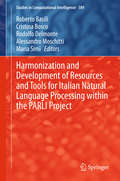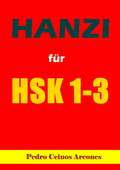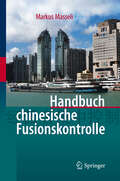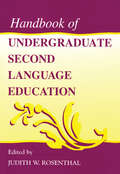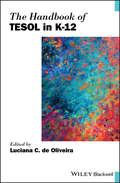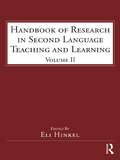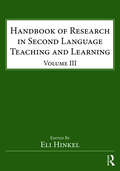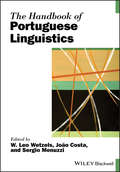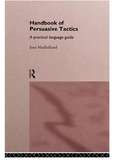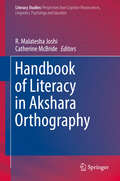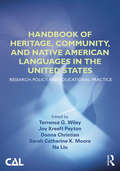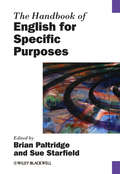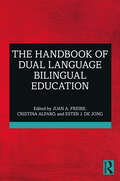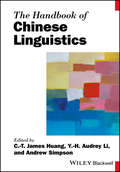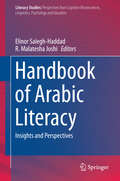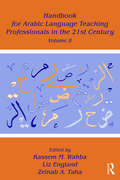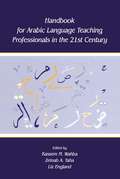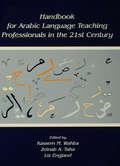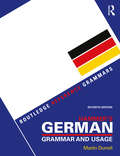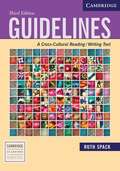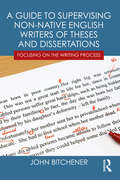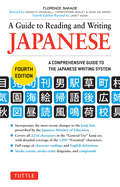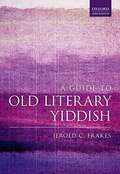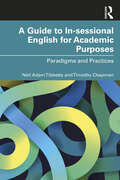- Table View
- List View
Harmonization and Development of Resources and Tools for Italian Natural Language Processing within the PARLI Project
by Roberto Basili Cristina Bosco Rodolfo Delmonte Alessandro Moschitti Maria SimiThe papers collected in this volume are selected as a sample of the progress in Natural Language Processing (NLP) performed within the Italian NLP community and especially attested by the PARLI project. PARLI (Portale per l'Accesso alle Risorse in Lingua Italiana) is a project partially funded by the Ministero Italiano per l'Università e la Ricerca (PRIN 2008) from 2008 to 2012 for monitoring and fostering the harmonic growth and coordination of the activities of Italian NLP. It was proposed by various teams of researchers working in Italian universities and research institutions. According to the spirit of the PARLI project, most of the resources and tools created within the project and here described are freely distributed and they did not terminate their life at the end of the project itself, hoping they could be a key factor in future development of computational linguistics.
HANZI für HSK 1 - 3
by Pedro Ceinos ArconesEine Weg, um chinesische Schriftzeichen auf eine einfache Weise zu lernen Das Buch umfasst die 600 Schriftzeichen, die man für HSK -Level 1 bis 3 benötigt
Handbuch chinesische Fusionskontrolle
by Markus Masseli, Dipl.-Kfm., LL.M.eurDas Handbuch ermöglicht eine Risikoeinschätzung geplanter Fusionen und dient als Argumentationshilfe und Anleitung für Fusionskontrollverfahren in China. Es orientiert sich an den für die Praxis maßgeblichen Gesichtspunkten und geht dabei auf die chinesische Fallpraxis und die Diskussion in der chinesischen Rechtsliteratur ein. Berücksichtigung finden auch die politischen und kulturellen Besonderheiten Chinas. Der Anhang enthält Übersetzungen der wichtigsten Rechtsvorschriften, juristischer Entscheidungen sowie Formulare.
Handbook of Undergraduate Second Language Education
by Judith W. RosenthalThis volume offers the most comprehensive, up-to-date description of the wide array of second language programs currently available to undergraduate students in the United States and abroad. It brings together, for the first time, detailed descriptions of programs in foreign language, English as a second language (ESL), dual language (bilingual), American Sign Language, Native American, and heritage languages. Addressing both theory and practice, the volume presents the historical development, current practices, and future directions of each type of program, along with detailed case studies. For second language teachers, academic administrators, and teacher educators, this Handbook provides information that will be useful in making instructional and programmatic planning decisions.
The Handbook of TESOL in K-12 (Blackwell Handbooks in Linguistics)
by Luciana C. de OliveiraThe first handbook to explore the field of Teaching English to Speakers of Other Languages in elementary and secondary education (K-12) The number of students being educated in English has grown significantly in modern times — globalization, immigration, and evolving educational policies have prompted an increased need for English language learner (ELL) education. The Handbook of TESOL in K-12 combines contemporary research and current practices to provide a comprehensive overview of the origins, evolution, and future direction of Teaching English to Speakers of Other Languages at the elementary and secondary levels (K-12). Exploring the latest disciplinary and interdisciplinary issues in the field, this is a first-of-its-kind Handbook and contributions are offered from a team of internationally-renowned scholars. Comprehensive in scope, this essential Handbook covers topics ranging from bilingual language development and technology-enhanced language learning, to ESOL preparation methods for specialist and mainstream teachers and school administrators. Three sections organize the content to cover Key Issues in Teaching ESOL students in K-12, Pedagogical Issues and Practices in TESOL in K-12 Education, and School Personnel Preparation for TESOL in K-12. Satisfies a need for inclusive and in-depth research on TESOL in K-12 classrooms Presents a timely and interesting selection of topics that are highly relevant to working teachers and support staff Applies state-of-the-art research to real-world TESOL classroom settings Offers a balanced assessment of diverse theoretical foundations, concepts, and findings The Handbook of TESOL in K-12 is an indispensable resource for undergraduate and graduate students, researchers and scholars, and educators in the field of Teaching English to Speakers of Other Languages in elementary and secondary education.
Handbook of Research in Second Language Teaching and Learning: Volume 2 (ESL & Applied Linguistics Professional Series)
by Eli HinkelThis landmark volume provides a broad-based, comprehensive, state-of-the-art overview of current knowledge and research into second language teaching and learning. All authors are leading authorities in their areas of expertise. The chapters, all completely new for Volume 2, are organized in eight thematic sections: Social Contexts in Research on Second Language Teaching and Learning Second Language Research Methods Second Language Research and Applied Linguistics Research in Second Language Processes and Development Methods and Instruction in Second Language Teaching Second Language Assessment Ideology, Identity, Culture, and Critical Pedagogy in Second Language Teaching and Learning Language Planning and Policy. Changes in Volume 2: captures new and ongoing developments, research, and trends in the field surveys prominent areas of research that were not covered in Volume 1 includes new authors from Asia, Australia, Europe, and North America to broaden the Handbook’s international scope. Volume 2 is an essential resource for researchers, faculty, teachers, and students in MA-TESL and applied linguistics programs, as well as curriculum and material developers.
Handbook of Research in Second Language Teaching and Learning: Volume III (ESL & Applied Linguistics Professional Series)
by Eli HinkelVolume III of the Handbook of Research in Second Language Teaching and Learning, like Volumes I and II, is a comprehensive, state-of-the-art overview of current research into social contexts of second language (L2)/foreign language (FL) teaching and learning; language policy; curriculum; types of instruction; incremental language skills such as listening, speaking, reading, writing, vocabulary, and grammar; international communication; pragmatics; assessment and testing. It differs from earlier volumes in its main purpose—to provide a more in-depth discussion and detailed focus on the development of the essential language skills required for any type of communication: speaking, listening, reading, vocabulary, grammar, and writing. Volume III preserves continuity with previous volumes in its coverage of all the classical areas of research in L2/FL teaching and learning and applied linguistics, but rather than offering a historical review of disciplinary traditions, it explores innovations and new directions of research, acknowledges the enormous complexity of teaching and learning the essential language abilities, and offers a diversity of perspectives. Chapter authors are all leading authorities in their disciplinary areas. What’s new in Volume III? Updates the prominent areas of research, including the sub-disciplines addressed in Volumes I and II, and represents the disciplinary mainstays Considers and discusses perspectives held by different schools of thought on the what, the how, and the why of teaching foundational language skills, including theories, pedagogical principles, and their implementation in practice Captures new and ongoing developments and trends in the key areas of L2/FL teaching and learning, and innovative research topics that have gained substantial recognition in current publications, including the role of corpora, technology, and digital literacy in L2/FL teaching and learning Examines new trends in language pedagogy and research, such as an increased societal emphasis on teaching academic language for schooling, somewhat contradictory definitions of literacy, and the growing needs for instruction in intercultural communication.
The Handbook of Portuguese Linguistics
by W. Leo Wetzels Sergio Menuzzi João CostaThe Handbook of Portuguese Linguistics presents a comprehensive overview of research within the Brazilian and European variants of the Portuguese language. It includes chapters focusing on the key areas of linguistic study, including phonetics, phonology, morphology, syntax, semantics, pragmatics, linguistic change, language variation and contact, and acquisition. Essential reference work for scholars of Portuguese linguistics and Romance languages Chapters written by an international team of research specialists highlight both the consensus and the controversies within the various subfields of Portuguese linguistics Examines Portuguese linguistics in relation to syntax, phonology, morphology, semantics/pragmatics, acquisition, and sociolinguistics Written in an accessible overview style and designed for advanced students and current scholars in the field alike Essential reference work for scholars of Portuguese linguistics and Romance languages
A Handbook of Persuasive Tactics: A Practical Language Guide
by Joan MulhollandMost people have to communicate with colleagues every day and persuade them to understand their opinions or to accept their views. This handbook is intended for anyone who is interested in such goal-oriented language. It extracts 300 persuasive tactics from research findings in communication, linguistics, pragmatics and related fields, and presents them in a clear, concise and consistent manner. Such tactics as analogy, argument presentation, humour and metaphor are included. Each tactic is presented on a separate page with an analysis of its persuasive value. Two indexes - one by persuasive need and the other by tactic - allow readers full flexibility to use the handbook in their own way. This work should be of interest in courses which deal with the management of interaction, pragmatics, discourse analysis and communications.
Handbook of Literacy in Akshara Orthography (Literacy Studies #17)
by R. Malatesha Joshi Catherine McBrideThis volume examines the unique characteristics of akshara orthography and how they may affect literacy development and problems along with the implications for assessment and instruction. Even though akshara orthography is used by more than a billion people, there is an urgent need for a systematic attempt to bring the features, research findings, and future directions of akshara together in a coherent volume. We hope that this volume will bridge that gap. Akshara is used in several Indic languages, each calling it by a slightly different name, for example 'aksharamu', in Telugu, 'akshara' in Kannada, and 'akshar' in Hindi. It is the Bhrami-derived orthography used across much of the Indian subcontinent. There is a growing body of research on the psycholinguistic underpinnings of learning to read akshara, and the emerging perspective is that akshara, even though classified as alphasyllabaries, abugida, and semi-syllabic writing systems, is neither alphabetic nor syllabic. Rather, akshara orthography is unique and deserves to be a separate classification and needs further investigation relating to literacy acquisition in akshara. The chapters in this volume, written by leading authors in the field, will inform the reader of the current research on akshara in a coherent and systematic way.
Handbook of Heritage, Community, and Native American Languages in the United States: Research, Policy, and Educational Practice
by Sarah Catherine K. Moore Donna Christian Joy Kreeft Peyton Terrence G. Wiley Na LiuCo-published by the Center for Applied Linguistics Timely and comprehensive, this state-of-the-art overview of major issues related to heritage, community, and Native American languages in the United States, based on the work of noted authorities, draws from a variety of perspectives—the speakers; use of the languages in the home, community, and wider society; patterns of acquisition, retention, loss, and revitalization of the languages; and specific education efforts devoted to developing stronger connections with and proficiency in them. Contributions on language use, programs and instruction, and policy focus on issues that are applicable to many heritage language contexts. Offering a foundational perspective for serious students of heritage, community, and Native American languages as they are learned in the classroom, transmitted across generations in families, and used in communities, the volume provides background on the history and current status of many languages in the linguistic mosaic of U.S. society and stresses the importance of drawing on these languages as societal, community, and individual resources, while also noting their strategic importance within the context of globalization.
The Handbook of English for Specific Purposes (Blackwell Handbooks in Linguistics #120)
by Brian Paltridge Sue StarfieldFeaturing a collection of newly commissioned essays, edited by two leading scholars, this Handbook surveys the key research findings in the field of English for Specific Purposes (ESP). • Provides a state-of-the-art overview of the origins and evolution, current research, and future directions in ESP • Features newly-commissioned contributions from a global team of leading scholars • Explores the history of ESP and current areas of research, including speaking, reading, writing, technology, and business, legal, and medical English • Considers perspectives on ESP research such as genre, intercultural rhetoric, multimodality, English as a lingua franca and ethnography
The Handbook of Dual Language Bilingual Education
by Juan A. Freire Cristina Alfaro de Jong, Ester JThis handbook presents a state-of-the-art overview of dual language bilingual education (DLBE) research, programs, pedagogy, and practice. Organized around four sections—theoretical foundations; key issues and trends; school-based practices; and teacher and administrator preparation—the volume comprehensively addresses major and emerging topics in the field. With contributions from expert scholars, the handbook highlights programs that honor the assets of language-minoritized and marginalized students and provides empirically grounded guidance for asset-based instruction. Chapters cover historical and policy considerations, leadership, family relations, professional development, community partnerships, race, class, gender, and more. Synthesizing major issues, discussing central themes and advancing policy and practice, this handbook is a seminal volume and definitive reference text in bilingual/second language education.
The Handbook of Chinese Linguistics (Blackwell Handbooks in Linguistics)
by C.-T. James Huang Y.-H. Audrey Li Andrew SimpsonThe Handbook of Chinese Linguistics is the first comprehensive introduction to Chinese linguistics from the perspective of modern theoretical and formal linguistics. Containing twenty-five chapters, the book offers a balanced, accessible and thoughtfully organized introduction to some of the most important results of research into Chinese linguistics carried out by theoretical linguists during the last thirty years. Presenting critical overviews of a wide range of major topics, it is the first to meet the great demand for an overview volume on core areas of Chinese linguistics.Authoritative contributions describe and assess the major achievements and controversies of research undertaken in each area, and provide bibliographies for further reading. The contributors refer both to their own work in relevant fields, and objectively present a range of competitor theories and analyses, resulting in a volume that is fully comprehensive in its coverage of theoretical research into Chinese linguistics in recent years. This unique Handbook is suitable both as a primary reader for structured, taught courses on Chinese linguistics at university level, and for individual study by graduates and other professional linguists.
Handbook of Arabic Literacy
by Elinor Saiegh-Haddad R. Malatesha JoshiThis book provides a synopsis of recently published empirical research into the acquisition of reading and writing in Arabic. Its particular focus is on the interplay between the linguistic and orthographic structure of Arabic and the development of reading and writing/spelling. In addition, the book addresses the socio-cultural, political and educational milieu in which Arabic literacy is embedded. It enables readers to appreciate both the implications of empirical research to literacy enhancement and the challenges and limitations to the applicability of such insights in the Arabic language and literacy context. The book will advance the understanding of the full context of literacy acquisition in Arabic with the very many factors (religious, historical, linguistic etc. ) that interact and will hence contribute to weakening the anglocentricity that dominates discussions of this topic.
Handbook for Arabic Language Teaching Professionals in the 21st Century, Volume II
by Kassem M. Wahba Liz England Zeinab A. TahaDrawing on the collective expertise of language scholars and educators in a variety of subdisciplines, the Handbook for Arabic Language Teaching Professionals in the 21st Century, Volume II, provides a comprehensive treatment of teaching and research in Arabic as a second and foreign language worldwide. Keeping a balance among theory, research and practice, the content is organized around 12 themes: Trends and Recent Issues in Teaching and Learning Arabic Social, Political and Educational Contexts of Arabic Language Teaching and Learning Identifying Core Issues in Practice Language Variation, Communicative Competence and Using Frames in Arabic Language Teaching and Learning Arabic Programs: Goals, Design and Curriculum Teaching and Learning Approaches: Content-Based Instruction and Curriculum Arabic Teaching and Learning: Classroom Language Materials and Language Corpora Assessment, Testing and Evaluation Methodology of Teaching Arabic: Skills and Components Teacher Education and Professional Development Technology-Mediated Teaching and Learning Future Directions The field faces new challenges since the publication of Volume I, including increasing and diverse demands, motives and needs for learning Arabic across various contexts of use; a need for accountability and academic research given the growing recognition of the complexity and diverse contexts of teaching Arabic; and an increasing shortage of and need for quality of instruction. Volume II addresses these challenges. It is designed to generate a dialogue—continued from Volume I—among professionals in the field leading to improved practice, and to facilitate interactions, not only among individuals but also among educational institutions within a single country and across different countries.
Handbook for Arabic Language Teaching Professionals in the 21st Century
by Kassem M. Wahba Liz England Zeinab A. TahaThis landmark volume offers an introduction to the field of teaching Arabic as a foreign or second language. Recent growth in student numbers and the demand for new and more diverse Arabic language programs of instruction have created a need that has outpaced the ability of teacher preparation programs to provide sufficient numbers of well-qualified professional teachers at the level of skill required. Arabic language program administrators anticipate that the increases in enrollment will continue into the next decades. More resources and more varied materials are seriously needed in Arabic teacher education and training. The goal of this Handbook is to address that need.The most significant feature of this volume is its pioneer role in approaching the field of Arabic language teaching from many different perspectives. It offers readers the opportunity to consider the role, status, and content of Arabic language teaching in the world today. The Handbook is intended as a resource to be used in building Arabic language and teacher education programs and in guiding future academic research. Thirty-four chapters authored by leaders in the field are organized around nine themes:*Background of Arabic Language Teaching;*Contexts of Arabic Language Teaching;*Communicative Competence in Arabic;*The Learners;*Assessment;*Technology Applications;*Curriculum Development, Design, and Models;*Arabic Language Program Administration and Management; and*Planning for the Future of Arabic Language Learning and Teaching.The Handbook for Arabic Language Teaching Professionals in the 21st Century will benefit and be welcomed by Arabic language teacher educators and trainers, administrators, graduate students, and scholars around the world. It is intended to create dialogue among scholars and professionals in the field and in related fields--dialogue that will contribute to creating new models for curriculum and course design, materials and assessment tools, and ultimately, better instructional effectiveness for all Arabic learners everywhere, in both Arabic-speaking and non-Arabic speaking countries.
Handbook for Arabic Language Teaching Professionals in the 21st Century
by Kassem M. Wahba Zeinab A. Taha Liz EnglandThis landmark volume offers an introduction to the field of teaching Arabic as a foreign or second language. Recent growth in student numbers and the demand for new and more diverse Arabic language programs of instruction have created a need that has outpaced the ability of teacher preparation programs to provide sufficient numbers of well-qualified professional teachers at the level of skill required. Arabic language program administrators anticipate that the increases in enrollment will continue into the next decades. More resources and more varied materials are seriously needed in Arabic teacher education and training. The goal of this Handbook is to address that need.The most significant feature of this volume is its pioneer role in approaching the field of Arabic language teaching from many different perspectives. It offers readers the opportunity to consider the role, status, and content of Arabic language teaching in the world today. The Handbook is intended as a resource to be used in building Arabic language and teacher education programs and in guiding future academic research. Thirty-four chapters authored by leaders in the field are organized around nine themes: Background of Arabic Language Teaching; Contexts of Arabic Language Teaching; Communicative Competence in Arabic; The Learners; Assessment; Technology Applications; Curriculum Development, Design, and Models; Arabic Language Program Administration and Management; and Planning for the Future of Arabic Language Learning and Teaching. The Handbook for Arabic Language Teaching Professionals in the 21st Century will benefit and be welcomed by Arabic language teacher educators and trainers, administrators, graduate students, and scholars around the world. It is intended to create dialogue among scholars and professionals in the field and in related fields--dialogue that will contribute to creating new models for curriculum and course design, materials and assessment tools, and ultimately, better instructional effectiveness for all Arabic learners everywhere, in both Arabic-speaking and non-Arabic speaking countries.
Hammer's German Grammar and Usage: Exercises (Routledge Reference Grammars)
by Martin DurrellLong trusted as the most comprehensive, up-to-date and user-friendly grammar available, Hammer’s German Grammar and Usage provides you with a complete guide to German as it is written and spoken today. In a revised layout to improve ease of consultation, this new edition includes: concise descriptions of the main grammatical phenomena of German and their use completely reorganized tables of grammatical features examples of grammar taken from contemporary German, helping you to understand the underlying grammatical principles more quickly invaluable guidance on pronunciation and word stress discussion of new words from English roots, helping you to communicate in German as Germans do today clarification on current spellings of German with full detail on the most recent revisions to the rules list of useful internet resources for students, teachers and all learners of German Praised for its lucid explanations, this new edition explains and clearly distinguishes formal and informal spoken and written usage. Hammer’s German Grammar offers you a combination of reference grammar and manual of current usage that you will find invaluable, whether a student or a teacher, at intermediate or advanced level.
Hairs / Pelitos
by Sandra CisnerosIn English and Spanish, a child describes how each person in the family has hair that looks and acts different, Papa's like a broom, Kiki's like fur, and Mama's with the smell of warm bread.
Guidelines: A Cross-Cultural Reading/Writing Text (Third Edition)
by Ruth SpackAn advanced reading and writing text designed specifically to strengthen students' academic writing. The cross-cultural readings in Guidelines offer a wide range of thought-provoking subject matter, varying in genre, viewpoint, length, and style. As students respond to the readings and work their way through the writing assignments, they are assisted by strategies laid out in 'Guidelines' boxes and by examples from other student writers. Writing assignments include research writing and essays that synthesize sources, critique arguments, and analyze fiction. A handbook is included as a reference guide in the back of the book. It contains sections on documenting sources, drafting and revising, and correcting grammatical errors. Guidelines, Third edition, is a major revision. The readings have been updated, the chapters are easier to navigate, and the 'Guidelines' now include references to the Internet as a means of research.
A Guide to Supervising Non-native English Writers of Theses and Dissertations: Focusing on the Writing Process
by John BitchenerFocused on the writing process, A Guide to Supervising Non-native English Writers of Theses and Dissertations presents approaches that can be employed by supervisors to help address the writing issues or difficulties that may emerge during the provisional and confirmation phases of the thesis/dissertation journey. Pre-writing advice and post-writing feedback that can be given to students are explained and illustrated. A growing number of students who are non-native speakers of English are enrolled in Masters and PhD programmes at universities across the world where English is the language of communication. These students often encounter difficulties when writing a thesis or dissertation in English – primarily, understanding the requirements and expectations of the new academic context and the conventions of academic writing. Designed for easy use by supervisors, this concise guide focuses specifically on the relationship between reading for and preparing to write the various part-genres or chapters; the creation of argument; making and evaluating claims, judgements and conclusions; writing coherent and cohesive text; meeting the generic and discipline-specific writing conventions; designing conference abstracts and PowerPoint presentations; and writing journal articles.
A Guide to Reading and Writing Japanese
by Janet Ikeda Kenneth Henshall Christopher Seeley Henk De GrootThis is an essential study tool for students seeking to learn Japanese and dramatically improve their kanji and kana. Students have been reading and writing Japanese for centuries, and they build their knowledge most successfully when they rely on a trusted resource. Today's most trusted-and readily available-resource is A Guide to Reading and Writing Japanese. This classic, best-selling learning and reference work, trusted by beginning and intermediate students learning Japanese since 1959, is now being offered as a fourth edition and is thoroughly revised and up-to-date. Having a knowledge of the full set of General Use characters, which this guide includes, will allow reading of any Japanese newspaper with ease and confidence. Key features on this revised edition include: The most recent changes prescribed by the Japanese Ministry of Education. Covers all the 2,136 characters in the 'General Use' / Joyo Kanji set. Detailing coverage of the 1,009 'Essential' Japanese characters arranged by grade for children in the first six years of grade school. The Kanji characters based more on their frequency in everyday language than the complexity of their composition.
A Guide to Old Literary Yiddish
by Jerold C. FrakesThis book is a comprehensive introductory manual that guides beginners to a functional reading knowledge of late medieval and early modern Yiddish (c.1100-1750). It is the first such manual to exist for that language, whose early literary tradition comprises a range of genres as broad as other contemporary European literary traditions. <p><p>The guide is organized as a series of progressively more complex lessons, focused on key texts of the literary corpus, which are presented in their authentic form as found in manuscripts and early printed books. The lessons seek to accommodate readers ranging from absolute beginners to those who might already know Hebrew, medieval German, or modern Yiddish. The focal texts are the Old Yiddish midrashic heroic lay,'Joseph the Righteous', from the earliest extant manuscript collection of Yiddish literature (1382), the Middle Yiddish romance adventure tale, 'Briyo and Zimro', from a later collection (1585), and a full canto of the Middle Yiddish epic, Pariz and Viene (1594), each with full glosses and a step-by-step introduction to the morphology, syntax, and phonology. Each lesson also includes a brief supplemental text that cumulatively demonstrates the broad cultural range of the corpus. In addition, several appendices of supplementary material round out the volume, including a collection of additional readings, a table of the manuscript hands and printing fonts employed in the volume, and a full end-glossary of all Yiddish words found in the texts.
A Guide to In-sessional English for Academic Purposes: Paradigms and Practices
by Neil Adam Tibbetts Timothy ChapmanA hands-on guide for practitioners, this book prepares instructors to teach in-sessional English for Academic Purposes (ISEAP) higher education courses. As university cohorts become more diverse, there is demand for in-sessional EAP courses not only to support international students, but also increasingly as a provision for all students. This informative resource explores the varying formats of ISEAP courses and how they are embedded within and alongside students’ degree programmes in the United Kingdom and beyond. In accessible chapters, authors Neil Adam Tibbetts and Timothy Chapman present illuminating findings drawn from interviews conducted with experts in the field and highlight the challenges that students and practitioners face. Avoiding prescriptive recommendations, Tibbetts and Chapman address different models and contexts of ISEAP courses at the university level and offer guidance and tools for practice. Covering key topics such as pedagogies, logistical challenges, and the wider university context, this book not only provides a roadmap to the often ill-defined but essential domain of ISEAP but also provokes questions and ideas for further reflection, guiding the reader towards a deeper understanding of their role and development in context. Engaging and inviting, Tibbetts and Chapman’s helpful text is a necessary resource for teachers to design and lead successful ISEAP courses.
